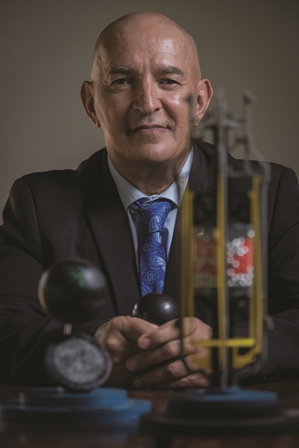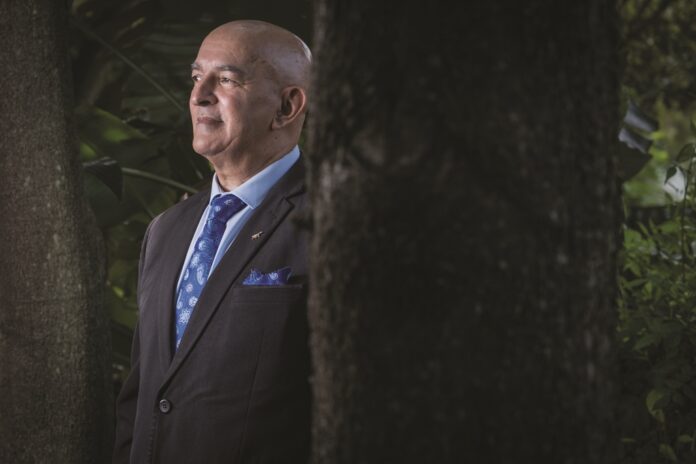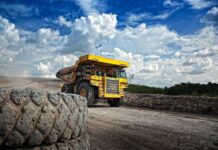What is generation four technology?
The main aspect in nuclear is always safety. Generation four is the highest league where the pebble technology is classified as inherently safe. You do not need passive and active safety systems because of the fuel technology that is used.
The fuel technology has four inherent safety barriers. The pebble fuel has a low power density of 5MW/dm3, compared to PWR fuel which has a fuel density of 20MW/dm3. The pebble coefficient of reactivity is negative. This implies that the fission process requires continuous activation, and if not activated continuously, the fission process decay will decrease and die out. It has a negative reactivity coefficient and that’s a big plus because if you do have a human or mechanical mishap, the plant (through the chemical fission process) goes to sleep, it shuts down by itself.
There are safety mechanisms just for that rare occasion of an accident taking place. It has been demonstrated on a live plant that when severe cases of helium coolant in the reactor are removed, if the temperature of the pebbles goes above or near to 1 600, it suffocates the chemical fission process.
The majority of the over 400 nuclear reactors in the world are pressurised water reactor types; these are classified as generation two. With them, if the fission process does get out of hand, for example as happened at Chernobyl, then you need an active safety mechanism. You insert the control rods and if things continue, you need other systems to be in place.
After Chernobyl and the Three Mile Island challenges, the nuclear industry has learnt a lot and the international nuclear regulator, the International Atomic Energy Agency (IAEA) in Vienna, has now put out new safety regulations. For example, at Fukushima when they had that tsunami, all the safety aspects were adhered to during the design of the power plants at Fukushima Daiichi, but when that tsunami came a 20 m wave crashed into the nuclear power plant and knocked out the electrical system and the system which drives the pumps. So they had challenges. There we see that the active mechanisms were there as designed.
With Mozweli pebble technology generation four, you don’t need all those active or passive safety systems because our safety is in the pebble technology. The fuel that we use has its own four barriers of safety and that is a big plus.
In the future design of power plants, most nuclear vendors and designers are talking about generation three-and-a-half. It’s still a challenge, you can have a meltdown, but there are many safety systems. With a passive safety system like those on the pressurised water reactors, they are saying keep a swimming pool of water on top of the reactor building, so that you can release water onto the building to cool it down.
With Mozweli pebble technology generation four, you don’t need all those active or passive safety systems because our safety is in the pebble technology. The fuel that we use has its own four barriers of safety and that is a big plus.
Why is the term “pebble” used?
The fuel that we are using actually looks like tennis balls, spherical, or like a cricket ball. It’s 60 millimeters in diameter but in the past, the field looked like pebbles on a riverbed. Pebble is a misnomer.
What are the other advantages of pebble technology?
An advantage of pebble Small Modular reactors (SMRs) is that the power output is 100 megawatts, compared to the large conventional power plants, which is about 3 200MWe. You can construct, manufacture and get to market in eight years. The Chinese have done that. They started in 2010 and they commissioned in 2018. We take that parameter from the Chinese.
A normal pressurised water reactor takes 20 to 25 years in design and construction. With the PSMR your cost is reduced to US$800-million, your manufacturing is much more convenient and you get to market as quickly as possible.
Pebble nuclear reactors also don’t have to shut down for refuelling. It’s an online process that allows you to keep generating power while you add and remove fuel. For example Koeberg needs to shut down for a month or two to reshuffle the fuel. We don’t have that problem.
You can construct, manufacture and get to market in eight years.
How is The PSMR a mitigator of climate change?
When the power plant is running, for every megawatt of electricity produced there is zero carbon dioxide, zero sulphur dioxide and zero nitrous oxide. That’s why we say it mitigates climate change. A fossil power plant that produces electricity using coal, fossils, oil or gas is taxed for every megawatt ton of carbon dioxide produced. Every megawatt of energy produced by nuclear power is actually a positive, which you can sell to the airways who are producing carbon dioxide.
Does pebble technology store nuclear waste differently?
The pebbles are totally different to a conventional nuclear power plant. For pressurised water reactors, the high-density radiation is plutonium and that has to be kept in a pool of deuterium water. It has to be kept on site for a number of years until the high level of radiation is reduced and then it can be moved to a deep fault in the earth somewhere. You are taking uranium oxide out of the earth, you use it, and you put it back in the earth.
Some of the anti-nuclear people don’t want you to put it back because it’s radioactive. The storage of high-level nuclear waste is highly regulated. Every gram is accounted for by the IAEA.
In pebble technology, we have dry storage. We take the pebbles out of the reactor once we have used the energy, store it below the plant for 40 years and we monitor it. It’s a much safer option and we are doing research on recycling those pebbles. About seven grams of uranium is used; 90% of the pebble is graphite.
Why is the PSMR particularly relevant in the African context?
Our power plant does not depend on a large amount of water for cooling. It does not depend on the position of the power plant. Pressurised water reactors need the ocean or a river to cool down the process. We can put the power plant where the power is needed.
Take for example a mining house. We can place a Mozweli power plant of 100MWe where they are mining. The mine has a life of about 30 years which ties in with the life of the Mozweli power plant, which is 40 years.
We can put the power plant where the power is needed.
We are saying to African countries, here’s a Mozweli power plant as big as a soccer field, put it where you need the energy, 100MWe for your mines or for your people and off you go. You don’t need a lot of water and long transmission lines. That makes economic sense in Africa. The PSMR is ideally suited to place your power plant where you need the power. The time of long transmission lines has expired.
Can you create reactors smaller than 100MWe?
We market a 100MWe of nominal output power. The installed capacity is 144MWe. Four reactors are based on 25MWe each and that is your N minus-three redundancy. If one reactor and its turbine is in outage for maintenance or servicing, your three remaining reactors will guarantee you a 100MWe nominal output power for 40 years is the principle.
The Canadians have enquired about a 25MWe plant and we said we can look into that. The only shortcoming here is that the price of a 25MWe and the price of a 100MWe is the same, US$800-million. This is because the regulatory process remains the same and is just as intense. In any event, we encourage a client to take a 50MWe or a Mozweli MHTR100 flagship because they are going to come back in two or three years’ time saying, “We need some more power.”
Will the COP28 talks have an impact on the growth of your market?
There is a lot of talk that nuclear is the way to go for climate change mitigation. Going into the future, the economies of the world must be hydrogen-based. To make bulk hydrogen, you need bulk energy and that should come from a nuclear power plant. Hydrogen produced from a nuclear power plant is known as pink hydrogen. Hydrogen is made through Permeable Electrical Electrolysis (PEE), the latest technology.
The Europeans and the British are moving to hydrogen in a big way because they believe that all future technologies will move away from fossil fuels to hydrogen. We need to be supplying hydrogen and so we have a latch-on unit onto our power plant, which can produce hydrogen if electricity is not required at that time.
Do you get a sense that a future Integrated Resource Plan (IRP) might include more nuclear capacity?
The IRP that was signed in October 2019 allocates 2 500MWe to small modular reactors. That was put in there just to see how everybody would respond. That is an underscore, because Eskom has announced that it will shut down 10 gigawatts of coal-powered stations in the next 10 years, that is 10 000MWe. They are only going to replace that with 2 500MWe, so they are basically short of 7 500MWe.
There are talks to update the IRP to a 2022 version and they are looking at bigger support for nuclear. The process to go nuclear has been extremely well supported; even the anti-nuclear people have gone quiet because the pebble technology we are presenting is so safe. It’s important to understand that we have now mitigated all the questions that the anti-nuclear people have, and therefore government today feels comfortable that they can increase nuclear capacity.
The only way to go is nuclear because you don’t need to build additional transmission lines, you put the power where you need the power.
The age of large nuclear power plants like Koeberg, I don’t think will happen again. South Africa needs 300 Mozweli 100MWe power plants. In the next 10 years, we will lose 10 gigawatts from coal. You need to replace that with 100 Mozweli power plants. From 2030 to 2040, you will lose another 10 gigawatts from coal and you will have to replace that with another 100 Mozweli plants, and from 2040 to 2050 you will need another 100.
The proposal that we put to government for South Africa to be energy secure is that you actually need 300 plants, that’s 30 gigawatts of power, just to be back where we were in 1976. I believe the IRP will go through changes and there will be an increase.
Renewables will never be able to produce 30 000MWe in 30 years. There’s just not enough land space and the transmission lines don’t have the capacity. The only way to go is nuclear because you don’t need to build additional transmission lines, you put the power where you need the power.
Do you have a lobby group?

We have a public lobby group in the Eastern Cape which is very proactive and busy. As the Mozweli Group we are making progress and on the issue of affordability for the government, we agree with that. Government has made it clear that any vendor presenting a nuclear solution must also come with a financial solution.
We have spoken to financial investors who will gladly come into the country and invest and assist in the programme. That diffuses the accusations that government will not be able to afford nuclear.
The technology is sound, the proof of concept is working and the team is ready. It is a South African team and we have 26 years of experience. Why not?
Nobody will get hurt in the process, and you will have sustainable security of energy going forward.










